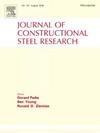Rocking interconnection for moment resisting modular buildings: Experimental and numerical investigation
IF 4
2区 工程技术
Q1 CONSTRUCTION & BUILDING TECHNOLOGY
引用次数: 0
Abstract
The speed of assembly and structural reliability of prefabricated prefinished volumetric constructions (PPVCs) are closely dependant on the interconnections linking modules. Among these interconnections, those with frictional mechanisms can offer greater efficiency in modular construction. This paper investigates the structural performance of a novel frictional interconnection through experimental and numerical studies. Initially, A joint composed of innovative interconnection and common intra-connection (beam-to-column connection) was prefabricated and tested under cyclic loading. The numerical models of the experimental sample are developed using ABAQUS software, subsequently validated against experimental results. Then, the impact of different support conditions (pin or roller) on joint behaviour is investigated. The outcomes indicates that the joint can effectively be used in moment-resisting frames in PPVCs as a result of its adequate stiffness, being classified as a rigid connection based on AISC 316–22. The interconnection reaches its maximum load capacity through rod yielding, while the other components remained intact. Numerical simulations reveal that no sliding occurs between the endplates during the test, indicating the adequacy of axial loads. Furthermore, changing the support conditions can affect the response of the joint, governed by the beam's and the interconnection's moment capacity.
抗弯矩模块化建筑的摇晃互联:实验和数值研究
预制预成品体积建筑(PPVC)的装配速度和结构可靠性与连接模块的互连装置密切相关。在这些连接件中,具有摩擦机制的连接件可以提高模块化建筑的效率。本文通过实验和数值研究探讨了新型摩擦互连的结构性能。首先,预制了一个由创新互连和普通内部互连(梁柱连接)组成的连接件,并在循环荷载下进行了测试。使用 ABAQUS 软件建立了实验样本的数值模型,随后根据实验结果进行了验证。然后,研究了不同支撑条件(销或辊)对连接行为的影响。研究结果表明,由于该连接件具有足够的刚度,可有效地用于 PPVC 的力矩抵抗框架,根据 AISC 316-22 标准被归类为刚性连接件。连接件通过杆件屈服达到最大承载能力,而其他组件保持完好。数值模拟显示,在测试过程中,端板之间没有发生滑动,这表明轴向载荷足够大。此外,改变支撑条件也会影响连接的响应,这取决于梁和互连的弯矩承载能力。
本文章由计算机程序翻译,如有差异,请以英文原文为准。
求助全文
约1分钟内获得全文
求助全文
来源期刊

Journal of Constructional Steel Research
工程技术-工程:土木
CiteScore
7.90
自引率
19.50%
发文量
550
审稿时长
46 days
期刊介绍:
The Journal of Constructional Steel Research provides an international forum for the presentation and discussion of the latest developments in structural steel research and their applications. It is aimed not only at researchers but also at those likely to be most affected by research results, i.e. designers and fabricators. Original papers of a high standard dealing with all aspects of steel research including theoretical and experimental research on elements, assemblages, connection and material properties are considered for publication.
 求助内容:
求助内容: 应助结果提醒方式:
应助结果提醒方式:


